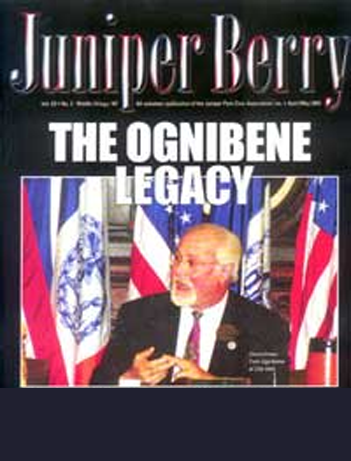Beginnings: Middle Village, as its name implies, was the halfway point between Jamaica and the Williamsburgh, a place where Queens farmers on their way to and from the Brooklyn or Manhattan markets on the Williamsburgh and Jamaica Turnpike (now Metropolitan Avenue) could park their wagons and enjoy a rest and refreshment. In 1652, before there was a turnpike, Middle Village/Maspeth was part of a new inland settlement attempted by English colonists who nine years earlier had been driven off by the Indian wars.
In 1660, records show that the Juniper Swamp, then part of Maspeth, Long Island, covered almost 100 acres. A century ago the Juniper swamp was covered by a forest of white cedar and overgrown with huge juniper trees. Because of the abundance of water, farming was prevalent throughout the area. Between Caldwell Avenue and Eliot Avenue there were numerous pear, cherry and apple trees.
Seventy years ago, dairy and vegetable farming was the main occupation in our neighborhood. Several greenhouses dotted the area.
Old maps show several large ponds in the area. Fresh Pond Road was named after a five acre pond just west of Juniper Valley Park. Hales Pond was located between Juniper Swamp (Valley) Road and Metropolitan Avenue. Ways’ Pond was located on Juniper Swamp Road. Other Ponds included Weiss Pond, Lacheters Pond, Brand Pond and a popular swimming hole called Fireman’s Pond, located behind the Fearless Fire Company near Pleasantview Street.
When the ponds froze, skating parties were organized and bonfires were lit along the shores. It was an old fashioned custom that brought neighbors together.
In the summer, animals grazed near the ponds while several neighborhood children would swim and fish. When farm chores were done, a dip in the pond was a great way to cool off.
In May, 1937, the city acquired the Juniper Swamp from the Arnold Rothstein estate for the sum $225,000, the amount of unpaid taxes. Rothstein, a gambler who was involved in the 1919 Chicago “Black Sox” scandal, had bought the land in the early 1920’s and erected a row of flimsy foundation-less houses. The brightly colored houses were designed to give the tract an air of a residential community and thus increase its price when he would sell it to the city for possible use as an airport. The scheme never materialized as Rothstein was murdered in 1928. Rothstein’s “phantom village” as it was called by many newspaper reporters, was torn down in the early 1930’s.
The city then made a nice profit on the deal (when it took over the land) in a manner that casts an ironic sidelight on the bizarre career of the “astute” gambler. For if Rothstein’s phantom village contractors had bothered to dig foundations for the imitation houses they put up, they would have unearthed valuable peat moss. As it was, the city found it and mined $500,000 worth. Now this humus material helps flowers grow at Jones Beach State Park, Northern State Parkway, Belt Parkway and many other parks and parkways.
There were large hills near Eliot Avenue between 69th Lane & 71st Street called the “Golf Links” or “High Hills,” by area residents. It was a popular area for neighborhood children. The hills were leveled in the late 1930’s and used as landfill for the Juniper Swamp.
In 1937, construction started on Eliot Avenue and plans for a development known as “Juniper Park Homes” also got under way. With the completion of the homes in 1938 came the civic organization known as “Residents of Juniper Park Homes.” In 1944, they merged with the Eliot Avenue Civic Association and became known as the Juniper Park Civic Association.
At the same time it was decided to use the Rothstein land for a park. Juniper Valley Park was built and completed around 1942 with 540 shade trees and numerous shrubs, paved play areas and four baseball fields.
Today the park has grown to 55 acres and is one of the most beautiful parks in the City of New York, thanks in part to the dozens of volunteers from the Juniper Park Civic Association.
Middle Village Turning Points: The Williamsburgh and Jamaica Turnpike in 1816 turned the farm community into a one-street town with houses and lodgings strung along the turnpike and a toll gate at either end. It remained largely a farmer's refreshment stop until the 1850s when Manhattan closed its churchyards, and Middle Village, along with neighboring Ridgewood and Glendale, became part of the Queens “cemetery belt.'' The Rev. Frederick W. Geissenhainer was first to purchase land south of Metropolitan Avenue for several Manhattan churches. It became Lutheran Cemetery in 1852. More cemeteries sprouted in the farmland, and so did florists, hotels and saloons to meet the varied needs of cemetery visitors.
Local Landmarks:
Niederstein's Restaurant-Hotel, built about 1865, became a favorite stopping-off place for the largely German population of the greater Ridgewood area, first for funeral parties, and later for weddings and banquets. It's still preserved as a restaurant, but is no longer used as a hotel.
Lutheran Cemetery became the city's most important Protestant burial grounds. Its permanent residents include victims of the General Slocum, an excursion boat that burned and sank during a Sunday School outing in 1904.
Pullis Farm Cemetery-Juniper Valley Park – A colonial farm cemetery of the Pullis family dating back to the 18th century. Ed Shusterich and other volunteers maintain the family plots and have planted dozens and trees and flowers in their honor.
Juniper Valley Park – The 55 acre park with a most interesting history is one of the most beautiful parks in the City of New York. It was recently described in New York Magazine as Queens’ Central Park.



